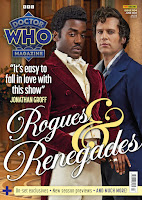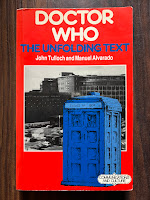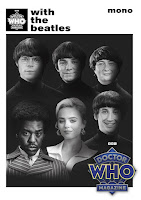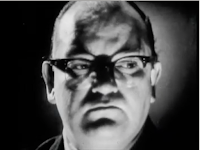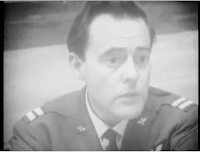This is an odd, beguiling time-travel romance first staged in 1926, then later adapted for radio, TV and two films.
John L Balderston chiefly wrote it, in collaboration with JC Squire — later the editor of
If It Had Happened Otherwise, a book exploring ways in which history might have been different — with the plot suggested by an
unfinished novel by Henry James. I find Balderston a fascinating figure — he adapted both
Dracula and
Frankenstein for the stage, and his versions were then the bases of the Universal movies. He wrote
The Bride of Frankenstein and worked on
Gone with the Wind and the US film version of
Gaslight.
Yet I’d never heard of Berkeley Square until it got mentioned in passing in an interview (more of which below). Given all the adaptations, it seems to have been very well known for three decades and was then lost to time — which is ironic given what it’s about.
The plot involves young Peter Standish, who has inherited a house in Berkeley Square in London, 1929. As the play opens, his strange behaviour is of concern to his fiancee, who calls in the US ambassador (one of Standish’s friends). Standish then somehow swaps places with his ancestor of the same name who is visiting the same house in 1784. The ancestor Standish is about to be engaged to his cousin Kate Pettigrew but Standish-from-the-future instead falls for Kate’s sister Helen…
At first, Standish-from-1929 is thrilled by the prospect of being back in the past and the opportunity to explore:
“How would you like to walk the quiet streets of London in the eighteenth century? … And breathe pure air, instead of gasolene? And ride in Sedan-chairs, instead of taxi-cabs. … See Sheridan at the first night of The School for Scandal, or hear Dr Johnson say the things Boswell wrote, or watch Reynolds at work…” (p. 38)
But the real past is a disappointment, such as when Standish meets Dr Johnson:
“Oh, he thundered out a few platitudes. Really, his friends ought to stop him from dribbling food and snuff all over his waistcoat. And he’d be none the worse for a bath.” (pp. 83-4.)
Worse, Johnson has, with Standish’s supposed friend Captain Clinton, paid for a good seat in front of Newgate prison to watch the burning of a woman called Phoebe Harris as punishment for coining. Standish is horrified by the brutality and also knows he can make no difference here: history cannot be changed.
The way Berkeley Square uses time travel is really interesting but some context is needed. Time travel stories weren’t new in 1929. They weren't just reserved for science-fiction either, but were very much in the mainstream. In A Christmas Carol (1843) by Charles Dickens, Ebeneezer Scrooge journeys back in time with a ghost to observe the formative events that have made him who he is. He then journeys forward in time with another ghost to see where his life and work will lead. This perspective prompts him to change his ways — and effectively change the future.
In
A Connecticut Yankee in King Arthur's Court (1889) by Mark Twain, Hank Morgan travels back in time and across the Atlantic to medieval England, where his knowledge of science is put to good use battling villains and injustice. Time travel again provides some perspective on social issues. That's not the only link between the two stories. From the way
A Christmas Carol is told, it’s possible Scrooge dreamt the whole adventure (but his unconscious still prompts him to change his ways), while Morgan may have imagined his journey to Camelot following a bump to the head. That was generally quite common: the
Encyclopedia of Science Fiction entry on time travel says that, “until the end of the nineteenth century, dreams were the favoured method.”
The Time Machine (1895) by HG Wells offered something very different. It begins with the unnamed time traveller discussing — with a psychologist, a provincial mayor, a medical man, a very young man, “an argumentative person with red hair” called Filby and the unnamed narrator — the physical principles of travel through time. It’s a scientific debate among a number of learned, sceptical people, positing time travel as a practical enterprise, a mechanical process accomplished with a machine.
Wells is vague on exactly what this machine comprises. It has “ivory bars”, “nickel bars”, a “brass rail” and “quartz rod”, but the traveller sits on a “saddle” rather than a seat or chair, which has always made me think of a sort of glorified bicycle. When the traveller works the starting lever, the sense is not that the traveller feels any motion. Instead, as he sits there, he watches a woman come into the room and head out through a different door — at unusual speed.
“I suppose it took her a minute or so to traverse the place, but to me she seemed to shoot across the room like a rocket. I pressed the lever over to its extreme position. The night came like the turning out of a lamp, and in another moment came tomorrow.” (
Chapter IV)
It’s as if the traveller is perched on a bicycle in front of a cinema screen, working a lever to speed up the film being shown until it passes in a blur.
There are other examples from the period, not least the unfinished novel by Henry James published in 1917 that Berkeley Square draws on. But I think Berkeley Square is situated somewhere between the dreams/subconscious of Dickens and Twain, and the physics of Wells. The play does not feature a time machine or tell us anything about how Peter Standish is able to swap places with his ancestor. But he does tell us quite a lot about the mechanics of time.
“Suppose you’re in a boat, sailing down a winding stream. You watch the banks as they pass you. You went by a grove of maple trees, upstream. But you can't see them now, so you saw them in the past, didn’t you? You’re watching a field of clover now; it’s before your eyes at this moment, in the present. But you don't know yet what’s around the bend in the stream there ahead of you; there may be wonderful things, but you can’t see them until you get around the bend in the future, can you?
Now remember, you’re in the boat. But I’m up in the sky above you, in a plane. I’m looking down on it all. I can see all at once the trees you saw upstream, the field of clover that you see now, and what's waiting for you around the bend ahead. All at once! So the past, present, and future of the man in the boat are all one to the man in the plane. Doesn't that show how all Time must really be one? Real Time with a capital T is nothing but an idea in the mind of God!” (p. 36)
A page later, Peter shares a limerick:
“There was a young lady named Bright
Whose movements were quicker than light
She went out one day, in a relative way
And came back on the previous night.” (p. 37)
These machinations on the behaviour of time don’t feature in James and surely come from Einstein. They’re also achingly new. It’s not just that perspective of time is relative to the observer. We also gain this perspective by using a then-new kind of vehicle — the plane.
Berkeley Square wasn’t the only work of fiction from this period to draw on Einstein as a dramatic conceit. A year before the play premiered,
Virginia Woolf’s novel Mrs Dalloway (1925) did something similar. That novel explores all sorts of aspects of time on people's lives and consciousness (and was written under the working title of
The Hours). Einstein is name-checked early on in the novel but his ideas about the relativistic effects of travel on our concept of time are demonstrated later on.
One character, Peter Walsh, returns to London after five years in India and goes to see Clarissa Dalloway. He has been moving while she has been in the same place all that time. The result is marked:
“And how are you?” said Peter Walsh, positively trembling; taking both her hands; kissing both her hands. She’s grown older, he thought, sitting down. I shan’t tell her anything about it, he thought, for she’s grown older. She’s looking at me, he thought, a sudden embarrassment coming over him, though he had kissed her hands. Putting his hand into his pocket, he took out a large pocketknife and half opened the blade.
Exactly the same, thought Clarissa; the same queer look; the same check suit; a little out of the straight his face is, a little thinner, dryer, perhaps, but he looks awfully well, and just the same.”
Basically, time has passed for Mrs Dalloway but not Peter.
In the case of Berkeley Square, I think Einstein is just bit of the zeitgeist thrown into the mix. The plot also features a
Crux ansata — an ankh — to suggest the eternal souls of our star-cross’d lovers, surely drawing on
Egytomania sparked by the discovery of Tutankhamen’s tomb in 1922 (Balderston later adapted
The Mummy for Universal).
Or there’s the eye-roll at modern life as the UK follows the US:
“Yes, cocktails, jazz and one universal traffic block—London’s just like New York.” (p. 29)
I wonder how much the fatalism was of its age, too. The horrors of the past can’t be changed and young lives can’t be saved, in a play staged less than a decade after the end of the First World War. No one here has any agency; the implication is that none of us do.
This seems to have connected with audiences of the time. According to JP Wearing’s
The London Stage 1920-1929 (p. 467),
Berkeley Square premiered at St Martin’s Theatre in London on 6 October 1926 and ran for an impressive 179 performances up to 5 March the following year. The cast included sisters Kate and Helen played by
Jean Forbes-Robertson and
Valerie Taylor. (I know Taylor as Nora in
Went the Day Well?, a film made in 1942 but bookended by a character addressing us from the future, after the end of the war.)
Taylor and some other members of the London cast of
Berkeley Square transferred to New York when the play opened at the Lyceum on 4 November 1929 with Leslie Howard in the lead role as Peter Standish. It ran for 229 performances.
Theatricalia lists multiple stage versions until 1949.
 |
1937 BBC radio
Berkeley Square,
image from Radio Times |
Howard and Taylor were in the
1933 film version available in full on YouTube. Howard was also in a
1937 radio production for the BBC, and the BBC broadcast other radio versions in
1935 (with Peggy Ashcroft as Helen), 1941, 1944 and 1951. That last one coincided with a second film version, now under the title
The House in the Square (aka
I’ll Never Forget You), with Tyrone Power in the title role (a version of this, with Gregory Peck, failed to get off the ground in 1945). And there were TV versions on the BBC in
1948 and
1959.
And then… Well, nothing. Whatever connection it made with the audience, it’s time has passed.
I’ve a copy of the script published by Longmans, Green and Company (London, New York and Toronto) in 1929, to coincide with the premiere on Broadway. I bought it because of a chance remark by New Zealand born playwright Jennifer Compton. She told Toby Hadoke for our Looking for David documentary that in 1973, while working on the play that became No Man's Land / Crossfire (in which feminists from different times meet in the same house), her tutor on NIDA's playwriting course advised her to read this old play.
 |
1959 BBC TV
Berkeley Square,
image from Radio Times |
That tutor was David Whitaker, the subject of my
book. I’m not sure when David discovered the play. He was working on staff in the BBC script department when the 1959 adaptation was made. Whenever he encountered it, I think it had a profound impact on his understanding of time while first story editor of
Doctor Who.
For one thing, the speech quoted above about the river and the plane is very like David’s own description of the mechanics of time, which he outlined in a reply to Doctor Who viewer Mr R Adams of Quinton on 1 May 1964 — a copy is held in file T5-649 Viewers Letters 1964 at the BBC’s Written Archives Centre in Caversham. David changes the metaphor a little: instead of a river observed from a plane, time is a winding road which the Doctor can observe from up on a hill. This position gives him perspective of the whole pattern but he cannot change or divert its path.
David wrote this letter on the same day that recording took place on The Temple of Evil (first episode of The Aztecs), in which the Doctor insists to companion Barbara that,
“You can't rewrite history! Not one line! … What you are trying to do is utterly impossible.”
A few months later, in Prisoners of the Conciergie, Barbara again probes what is possible. She has witnessed the young Napoleon Bonaparte in 1794 and later wonders what change she might have enacted with a few quiet words.
DOCTOR WHO:
Well, I can assure you my dear Barbara, Napoleon would never have believed you.
IAN:
Yes, Doctor but supposing we had written Napoleon a letter telling him, you know, some of the things that were going to happen to him.
SUSAN:
It wouldn’t have made any difference, Ian. He'd have forgotten it, or lost it or thought it was written by a maniac.
BARBARA:
I suppose if we’d tried to kill him with a gun, the bullet would have missed him.
This is in a story written by Dennis Spooner, who succeeded David as story editor — and immediately changed the rules. Spooner's next story, The Romans, has the Doctor directly influence the course of history, sparking the Great Fire of Rome. In Spooner’s next self-scripted story, The Time Meddler (1965), we meet a member of the Doctor's own people who can and does change history. David responded; his 1966 novelisation The Crusaders, based on a TV story he wrote for Spooner, begins with the Doctor once again insisting that history is immutable.
Spooner’s view of time has prevailed in Doctor Who. In fact, it’s given the Doctor a sense of purpose, as protector of the delicate web of time. That explains why the Doctor on some occasions can and on others cannot stand idly by and let things take their course. A classic example is in the 1975 story Pyramids of Mars, in which the Doctor and Sarah Jane Smith face a villain in the year 1911.
DOCTOR WHO:
If Sutekh isn’t stopped, he’ll destroy the world.
SARAH JANE:
But he didn't, did he? I mean, we know the world didn’t end in 1911.
DOCTOR WHO:
Do we?
He sets the controls of the TARDIS for Earth in 1980, where they find a desolate wasteland. Sarah acknowledges that they have to go back to stop Sutekh. Change is possible, even necessary. The sense is less of change as of moulding.
DOCTOR WHO:
Not chosen [but] shaped. The actions of the present fashion the future.
The threat of changing history therefore serves as motivation for the Doctor, and so has dramatic value. Not being able to change history makes the Doctor and the companions mere bystanders, and is so less dramatically satisfying. Yet David Whitaker stuck to his guns anyway - and I think that’s because Berkeley Square suggested the drama of not being able to change history, which is what gets explored in The Aztecs, one of the best acclaimed early stories.
It occurs to me that the series Quantum Leap owes (perhaps by coincidence) something to Berkeley Square in that its hero Sam Beckett swaps places with individuals in history in the same way that Peter Standish swaps with his ancestor. Yet the whole point of Quantum Leap is that Sam is tasked with changing history for the better, guided by his friend Al who can provide him with the odds of success in a probabilistic universe.
Anyway. I think Berkeley Square also influenced the middle section of David’s The Evil of the Daleks (1967). There's something of moral, outspoken Kate, good but timid Helen and their caddish brother Tom in Ruth Maxtible, Victoria Waterfield and Arthur Terrell. The TV story features a portrait of Victoria’s late mother, whereas in the play, the house in 1929 features a painting of Peter Standish by Sir Joshua Reynolds, painted during his trip to the past.
That painting has a bigger role in the play, where Reynolds is haunted by his subject.
REYNOLDS:
Something in your face eludes me … I thought at first it was irony. And yet, I fancy I know irony—and there is a quality in your every look, when I take up my brushes and fasten my eyes on your face, beyond all my experience of human nature. (p. 74)
As in the 2010 Doctor Who episode Vincent and the Doctor, the idea is that artists can see something the rest of us don’t. (The fact the Silents in 2011’s The Impossible Astronaut look so much like the figure in the famous painting The Scream suggest Edvard Munch had the same ability.)
Reading Berkeley Square again this weekend, it strikes me that the modern Peter Standish has a guide to his time in the past — his ancestor's diary. David Whitaker provided the Doctor with a diary when, in The Power of the Daleks (1966), the Second Doctor must take on the mantle of the First.
And, perhaps fittingly, there's a connection that the authors could never have known as it’s related to their future. David's novelisation of The Crusades includes the detail that the Doctor’s granddaughter has married a man called David Cameron; in the play, there's an important American character called Bill Clinton.
